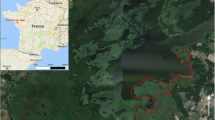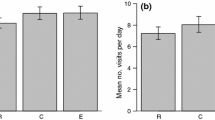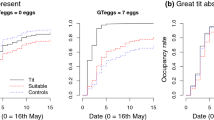Abstract
In precocial birds, adults select breeding areas using cues associated with habitat characteristics that are favorable for nesting success and chick survival, but there may be tradeoffs in habitat selection between these breeding stages. Here we describe habitat selection and intra-territory movements of 53 Piping Plover (Charadrius melodus) broods (320 observations) during the 2007–2008 breeding seasons on mainland- and island-shoreline habitats at Lake Sakakawea, North Dakota, USA. We used remotely sensed habitat characteristics to separately examine habitat selection and movements at two spatiotemporal scales to account for potential confounding effects of nest-site selection on brood-rearing habitat used. The scales used were (1) the entire brood-rearing period within available brood-rearing areas and (2) 2-day observation intervals within age-specific discrete habitat selection choice sets. Analyses at both scales indicated that broods selected areas which were non-vegetated, moderately level, and nearer to the shoreline. Rate of brood movement increased with age up to 5 days, then stabilized; broods that hatched >50 m away from the shoreline moved toward the shoreline. Brood movements were greater when they were in vegetated areas, when the brood-rearing area was of greater topographic complexity, and when broods aged 6–25 days were further away from the shoreline. Using inferences from our results and those of previously published work, we postulate how a potential tradeoff in habitat selection between nesting and brood-rearing can contribute to an ecological trap in a novel habitat. This work, in the context of published works, suggests that plover breeding habitat is a complex of both nesting and brood-rearing habitats and provides a basis for making remotely sensed abundance estimates of suitable breeding habitat for Piping Plovers.
Zusammenfassung
Habitatwahl und Ortsbewegungen von Bruten des Gelbfuß-Regenpfeifers zeigen Entscheidungskonflikte zwischen Brutstadien Bei Nestflüchtern wählen die adulten Vögel die Brutgebiete nach Habitateigenschaften, die von Vorteil sind für den Bruterfolg und für das Überleben der Küken, aber es könnte Entscheidungskonflikte (Tradeoffs) bei der Habitatwahl geben zwischen diesen verschiedenen Brutstadien. Wir beschrieben Habitatwahl und intraterritoriale Bewegungen von 53 Bruten des Gelbfuß-Regenpfeifers (Charadrius melodus) anhand von 320 Beobachtungen während der Brutsaison 2007–2008 in Habitaten der Küstenlinien des Festlands und von Inseln am See Sakakawea in North Dakota, USA. Wir verwendeten Habitateigenschaften aus Fernerkundungsdaten, um Habitatwahl und Bewegungen auf zwei raumzeitlichen Skalen einzeln zu betrachten und um zufällig verbundenen Effekten zwischen Brutplatzwahl und Aufzuchthabitat Rechnung zu tragen. Die verwendeten Skalen waren (1) die gesamte Aufzuchtperiode in für die Aufzucht verfügbaren Gebieten und (2) 2-tägige Beobachtungsintervalle innerhalb von altersspezifischen, diskreten Sätzen von Habitatauswahlmöglichkeiten. Die Analysen zeigten, dass für die Bruten Gebiete gewählt wurden, die unbewachsen waren, einigermaßen eben und näher an der Küste. Die Anzahl von Bewegungen in den Bruten nahm bis zum Alter von fünf Tagen zu und stabilisierte sich dann. Bruten, die mehr als 50 m von der Küste entfernt schlüpften, bewegten sich in Richtung der Küste. Die Bewegungen der Bruten waren größer in Gebieten mit Bewuchs, von höherer topographischer Komplexität und wenn 6 bis 25 Tage alte Bruten weiter von der Küste entfernt waren. Aus unseren eigenen Ergebnissen und veröffentlichten Arbeiten stellen wir zur Diskussion, wie ein möglicher Entscheidungskonflikt zwischen Brüten und Aufzucht bei der Habitatwahl zu einer ökologischen Falle in einem neuen Habitat beitragen kann. Diese Arbeit deutet im Kontext von früher veröffentlichten Arbeiten darauf hin, dass die Definition eines Bruthabitats beim Gelbfuß-Regenpfeifer aus einem Komplex besteht aus sowohl Habitat für Brüten als auch für Aufzucht. Sie schafft eine Grundlage zur Abschätzungen der Häufigkeit von Bruthabitaten für Gelbfuß-Regenpfeifer aus Fernerkundungsdaten.






Similar content being viewed by others
References
Amat JA, Masero JA (2004) Predation risk on incubating adults constrains the choice of thermally favourable nest sites in a plover. Anim Behav 67:293–300
Anderson DJ (1982) The home range: a new nonparametric estimation technique. Ecology 63:103–112
Anteau MJ, Sherfy MH (2010) Diurnal variation in invertebrate catch rates by sticky traps: potential for biased indices of Piping Plover forage. Wetlands 30:757–762
Anteau MJ, Shaffer TL, Sherfy MH, Sovada MA, Stucker JH, Wiltermuth MT (2012a) Nest survival of Piping Plovers at a dynamic reservoir indicates an ecological trap for a threatened population. Oecologia 170:1167–1179
Anteau MJ, Sherfy MH, Wiltermuth MT (2012b) Selection indicates preference in diverse habitats: a ground-nesting bird (Charadrius melodus) using reservoir shoreline. PLoS One 7:e30347
Anteau MJ, Shaffer TL, Wiltermuth MT, Sherfy MH (2014a) Landscape selection by Piping Plovers has implications for measuring habitat and population size. Landsc Ecol 29:1033–1044
Anteau MJ, Wiltermuth MT, Sherfy MH, Shaffer TL (2014b) Measuring and predicting abundance and dynamics of habitat for Piping Plovers on a large reservoir. Ecol Model 272:16–27
Anteau MJ, Wiltermuth MT, Sherfy MH, Shaffer TL, Pearse AT (2014c) Role of landscape features and density dependence in growth and fledging rates of Piping Plovers in North Dakota, USA. Condor 116:195–204
Arnold TW (2010) Uninformative parameters and model selection using Akaike’s information criterion. J Wildl Manage 74:1175–1178
Arthur SM, Manly BFJ, McDonald LL, Garner GW (1996) Assessing habitat selection when availability changes. Ecology 77:215–227
Blomqvist D, Johansson OC (1995) Trade-offs in nest site selection in coastal populations of lapwings Vanellus vanellus. Ibis 137:550–558
Brudney LJ, Arnold TW, Saunders SP, Cuthbert FJ (2013) Survival of Piping Plover (Charadrius melodus) chicks in the Great Lakes region. Auk 130:150–160
Burger J (1987) Physical and social determinants of nest-site selection in Piping Plover in New Jersey. Condor 89:811–818
Burnham KP, Anderson DR (2002) Model selection and multimodel inference: a practical information-theoretic approach, 2nd edn. Springer, New York
Calenge C (2006) The package “adehabitat” for the R software: a tool for the analysis of space and habitat use by animals. Ecol Model 197:516–519
Cooper AB, Millspaugh JJ (1999) The application of discrete choice models to wildlife resource selection studies. Ecology 80:566–575
Defos du Rau P, Barbraud C, Mondain-Monval J-Y (2003) Estimating breeding population size of the Red-crested pochard (Netta rufina) in the Camargue (southern France) taking into account detection probability: implications for conservation. Anim Conserv 6:379–385
Dreitz VJ (2009) Parental behaviour of a precocial species: implications for juvenile survival. J Appl Ecol 46:870–878
Elias SP, Fraser JD, Buckley PA (2000) Piping Plover brood foraging ecology on New York Barrier Islands. J Wildl Manage 64:346–354
Elliott-Smith E, Haig SM (2004) Piping Plover. In: Poole A (ed) The birds of North America Online. Cornell Laboratory of Ornithology, Ithaca. Available at: http://bna.birds.cornell.edu/BNA/account/Piping_Plover/
Elliott-Smith E, Haig SM, Powers BM (2009) Data from the 2006 International Piping Plover Census. U.S. Geol Surv Data Serv 426:332
Espie RHM, Brigham RM, James PC (1996) Habitat selection and clutch fate of Piping Plovers (Charadrius melodus) breeding at Lake Diefenbaker, Saskatchewan. Can J Zool 74:1069–1075
Espie RHM, James PC, Brigham RM (1998) The effects of flooding on Piping Plover (Charadrius melodus) reproductive success at Lake Diefenbaker, Saskatchewan, Canada. Biol Conserv 86:215–222
Gauthier G (1987) Brood territories in Buffleheads: determinants and correlates of territory size. Can J Zool 65:1402–1410
Gómez-Serrano MÁ, López-López P (2014) Nest site selection by Kentish Plover suggests a trade-off between nest-crypsis and predator detection strategies. PLoS One 9:e107121
Haffner CD, Cuthbert FJ, Arnold TW (2009) Space use by Great Lakes Piping Plovers during the breeding season. J Field Ornithol 80:270–279
Hays H, LeCroy M (1971) Field criteria for determining incubation stage in eggs of the Common Tern. Wilson Bull 83:425–429
Johnson DH (1980) The comparison of usage and availability measurements for evaluating resource preference. Ecology 61:65–71
Kenward R (1987) Wildlife radio tagging. Academic Press, London
Knetter JM, Lutz RS, Cary JR, Murphy RK (2002) A multi-scale investigation of Piping Plover productivity on Great Plains alkali lakes, 1994–2000. Wildlife Soc B 30:683–694
Kosztolányi A, Székely T, Cuthill I (2007) The function of habitat change during brood-rearing in the precocial Kentish Plover Charadrius alexandrinus. Acta Ethol 10:73–79
Kruse CD, Higgins KF, Vander Lee BA (2001) Influence of predation on Piping Plover, Charadrius melodus, and Least Tern, Sterna antillarum, productivity along the Missouri River in South Dakota. Can Field Nat 115:480–486
Le Fer D, Fraser JD, Kruse CD (2008a) Piping Plover chick foraging, growth, and survival in the Great Plains. J Wildl Manage 72:682–687
Le Fer D, Fraser JD, Kruse CD (2008b) Piping plover forage-site selection on the Missouri River. Waterbirds 31:587–592
Lengyel S (2007) Benefits of large broods by higher chick survival and better territories in a precocial shorebird. Behav Ecol Sociobiol 61:589–598
Loegering JP, Fraser JD (1995) Factors affecting Piping Plover chick survival in different brood-rearing habitats. J Wildl Manage 59:646–655
MacKenzie DI, Nichols JD, Lachman GB, Droege S, Andrew Royle J, Langtimm CA (2002) Estimating site occupancy rates when detection probabilities are less than one. Ecology 83:2248–2255
Manly BFJ, McDonald LL, Thomas DL, McDonald TL, Erickson WP (2002) Resource selection by animals: statistical design and analysis for field studies. Kluwer Academic, Boston
McDonald TL, Manly BFJ, Nielson RM, Diller LV (2006) Discrete-choice modeling in wildlife studies exemplified by Northern Spotted owl nighttime habitat selection. J Wildl Manage 70:375–383
Miller EH (1979) Functions of display flights by males of the Least Sandpiper, Calidris minutilla (Vieill.), on Sable Island, Nova Scotia. Can J Zool 57:876–893
Murphy RK, Root BG, Mayer PM, Goossen JP, Smith KA (1999) A draft protocol for assessing Piping Plover reproductive success on the Great Plains alkali lakes. In: Higgins K, Brashier M, Kruse CD (eds) Proceedings, Piping Plovers and Least Terns of the Great Plains and Nearby. South Dakota State University, Brookings, pp 90–107
Pearse AT, Ratti JT, Sheaffer (2004) Effects of predator removal on Mallard duckling survival. J Wildl Manag 68:342–350
Pehrsson O, Nyström KGK (1988) Growth and movements of Oldsquaw ducklings in relation to food. J Wildl Manage 52:185–191
Powell AN, Cuthbert FJ (1992) Habitat and reproductive success of Piping Plovers nesting on Great Lakes islands. Wilson Bull 104:155–161
Pöysä H, Elmberg J, Sjöberg K, Nummi P (2000) Nesting mallards (Anas platyrhynchos) forecast brood-stage food limitation when selecting habitat: experimental evidence. Oecologia 122:582–586
Prindiville Gaines EM, Ryan MR (1988) Piping Plover habitat use and reproductive success in North Dakota. J Wildl Manage 52:266–273
Development Core Team R (2010) R: a language and environment for statistical computing. R Foundation for Statistical Computing, Vienna
Robsertson BA, Hutto RL (2006) A framework for understanding ecological traps and an evaluation of existing evidence. Ecology 87:1075–1085
Roche EA, Gratto-Trevor CL, Goossen JP, White CL (2012) Flooding affects dispersal decisions in Piping Plovers (Charadrius melodus) in prairie Canada. Auk 129:296–306
Roche EA, Shaffer TL, Anteau MJ, Sherfy MH, Stucker JH, Wiltermuth MT, Dovichin CM (2014) Detection probability of Least Tern and Piping Plover chicks in a large river system. J Wildl Manag 78:709–720
Rotella JJ, Ratti JT (1992) Mallard brood movements and wetland selection in southwestern Manitoba. J Wildl Manag 56:508–515
Sargeant GA (2011) wild1: R tools for wildlife research and management, R package version 1.09 edn. U.S. Geol Surv Northern Prairie Wildlife Research Center, Jamestown
SAS Institute (2002) SAS/STAT user’s guide, version 9. SAS Institute, Cary
Schekkerman H, Visser GH (2001) Prefledging energy requirements in shorebirds: energetic implications of self-feeding precocial development. Auk 118:944–957
Sedinger JS (1992) Ecology of prefledging waterfowl. In: Batt BDJ (ed) Ecology and management of breeding waterfowl. University of Minnesota Press, Minneapolis
Shaffer TL, Sherfy MH, Anteau MJ, Stucker JH, Sovada MA, Roche EA, Wiltermuth MT, Buhl TK, Dovichin CM (2013) Accuracy of the Missouri River Least Tern and Piping Plover monitoring program: considerations for the future. U.S. Geological Survey Open File Report 2013–1176
Sherfy MH, Stucker JH, Anteau MJ (2009) Missouri River emergent sandbar habitat monitoring plan—a conceptual framework for adaptive management. U.S. Geological Survey Open-File Report 2008–1223. U.S. Geological Survey, Reston
Talent LG, Krapu GL, Jarvis RL (1982) Habitat use by Mallard broods in south central North Dakota. J Wildl Manage 46:629–635
Thompson WL, White GC, Gowan C (1998) Monitoring vertebrate populations. Academic Press, Sand Diego
US Army Corps of Engineers (USACE) (2010) Monthly reservoir summary (0168’s). US Army Corps of Engineers, Omaha
US Fish and Wildlife Service (USFWS) (1985) Endangered and threatened wildlife and plants: determination of endangered and threatened status for the Piping Plover; final rule. Fed Reg 50:50726–50734
Wilson CA, Colwell MA (2010) Movements and fledging success of Snowy Plover (Charadrius alexandrinus) chicks. Waterbirds 33:331–340
Wiltermuth MT, Anteau MJ, Sherfy MH, Shaffer TL (2009) Nest movement by Piping Plovers in response to changing habitat conditions. Condor 111:550–555
Acknowledgments
This study was funded by the U.S. Army Corps of Engineers’ Missouri River Recovery Program through financial and logistical support from the Corps’ Omaha District Threatened and Endangered Species Section and Garrison Project Office. We are grateful for technical support by the USGS Northern Prairie Wildlife Research Center Missouri River Least Tern and Piping Plover Research Team, and especially to Melisa Bernard, Betty Euliss, Nickolas Smith, and Larry Strong for assistance with spatial data and remote sensing. We thank Phil Brown, Deb Buhl, Tom Buhl, Colin Dovichin, Anthony Hipp, Coral Huber, Casey Kruse, Michael Morris, Terry Shaffer, Brandi Skone, Nickolas Smith, Marsha Sovada, Jennifer Stucker, and Ryan Williamson for their help with project planning and logistics, and the many field technicians for their assistance with data collection. We thank Juan A. Amat, Glen A. Sargeant, and anonymous reviewers for valuable comments on an earlier version of this manuscript. Our field protocols were approved by the USGS Northern Prairie Wildlife Research Center Animal Care and Use Committee. Any use of trade, product, or firm names is for descriptive purposes only and does not imply endorsement by the U.S. Government.
Author information
Authors and Affiliations
Corresponding author
Additional information
Communicated by C. Barbraud.
Rights and permissions
About this article
Cite this article
Wiltermuth, M.T., Anteau, M.J., Sherfy, M.H. et al. Habitat selection and movements of Piping Plover broods suggest a tradeoff between breeding stages. J Ornithol 156, 999–1013 (2015). https://doi.org/10.1007/s10336-015-1227-0
Received:
Revised:
Accepted:
Published:
Issue Date:
DOI: https://doi.org/10.1007/s10336-015-1227-0




